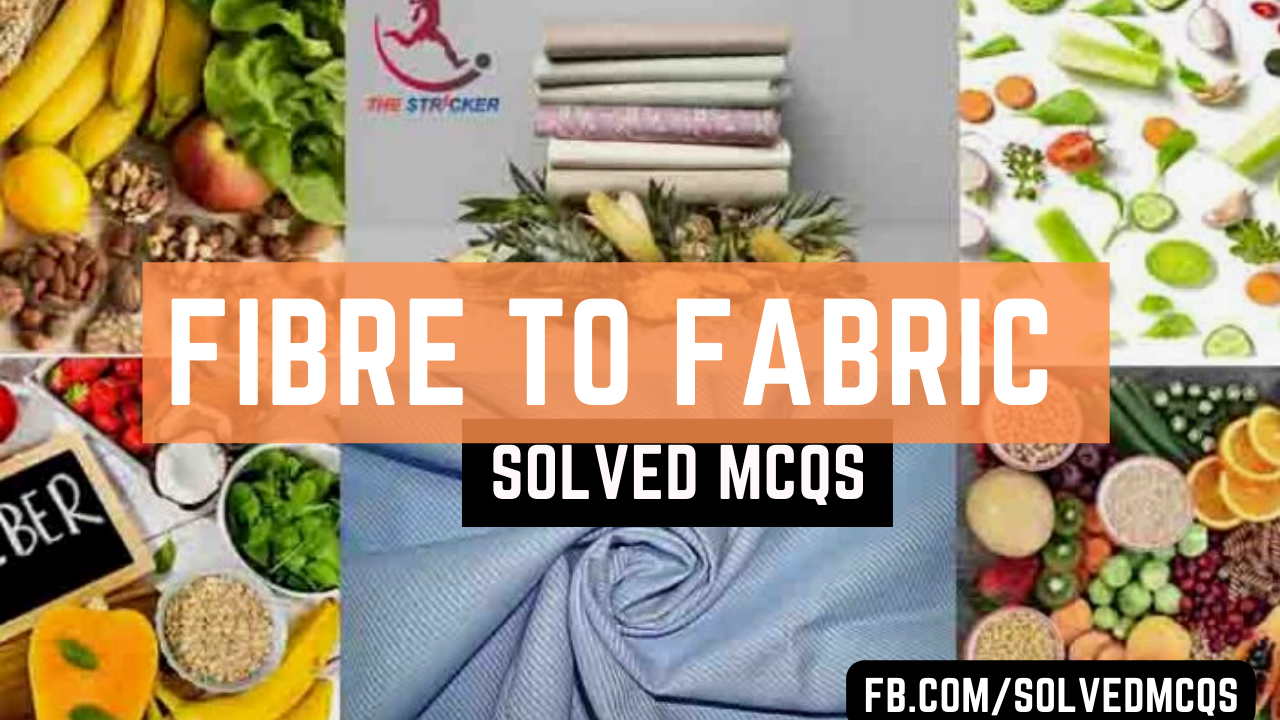Fibre to Fabric multiple-choice questions MCQs with Answers 1. Why do we wear wool fibers in winter? a. Wool can’t trap air and ...
Fibre to Fabric multiple-choice questions MCQs with Answers
1. Why do we wear wool fibers in winter?
a. Wool can’t trap air and thus prevent loss of heat from body
b. Wool trap air and prevent loss of heat from body
c. Wool keep us warm by conducting air
d. None of these
Answer: b. b. Wool trap air and prevent loss of heat from body
2. We get pashmina shawls from the wool of which animal?
a. Yak
b. Sheep
c. Angora goat
d. Kashmiri goat
Answer: d. Kashmiri goat
3. Removal of hair of animals along with a thin layer of skin is called:
a. Rolling
b. Scouring
c. Shearing
d. Sorting
Answer: c. Shearing
4. Cotton, jute, silk, and wool are:
a. Natural fibers
b. Hand-made fibers
c. Hand-made fabrics
d. Collective fibers
Answer: a. Natural fibres
a. Plants
b. Animals
c. Both plants and animals
d. From trees
Answer: a. Plants
6. Wool and silk fibers are obtained from:
a. Plants
b. Animals
c. Both plants and animals
d. All options
Answer: b. Animals
7. Wool is obtained from which of the following?
a. Fleece of sheep or goat
b. Hair of rabbits, Yak and camels
c. Plants
d. All options
Answer: a. Fleece of sheep or goat
8. Synthetic fiber is obtained from:
a. Plants
b. Animals
c. Both plants and animals
d. Chemical substances
Answer: d. Chemical substances
9. Which of the following are not examples of synthetic fibers?
a. Nylon
b. Jute
c. Acrylic
d. Polyester
Answer: b. Jute
10. Cotton plants are usually grown in:
a. Red soil
b. Laterite soil
c. Black soil
d. Stony soil
Answer: c. Black soil
11. The process of separation of cotton fibers from their seed is called:
a. Weaving
b. Ginning
c. Knitting
d. Shearing
Answer: b. Ginning
12. From which part of the plants’ jute is obtained?
a. Leaves
b. Fruit
c. Stem
d. Root
Answer: c. Stem
a. Ether
b. Cellulose
c. Amino acids
d. Ester
Answer: d. Ester
14. The first man-made fiber is:
a. Nylon
b. Polyester
c. Rayon
d. Cotton
Answer: c. Rayon
15. What do silk fibers consist of?
a. Vitamins
b. Carbohydrates
c. Proteins
d. Fats
Answer: c. Proteins
16. Cotton, wool, silk are all classified as…?
a. Plant Fibres
b. Animal Fibres
c. Natural Fibres
d. Synthetic Fibres
Answer: c. Natural Fibres
17. The rearing of silkworms for obtaining raw silk is known as…?
a. SilkKeeping
b. Silkculture
c. Sericulture
d. Wormculture
Answer: c. Sericulture
18. Rayon, Nylon and polyesters are all classified as…?
a. Plant Fibres
b. Animal Fibres
c. Natural Fibres
d. Synthetic Fibres
Answer: d. Synthetic Fibres
19. Which of the following is NOT a variety of silk?
a. Mulberry silk
b. Muga silk
c. Eri silk
d. Worm Silk
Answer: d. Worm Silk
20. Cotton, jute and coconut are all classified as…?
a. Plant Fibres
b. Animal Fibres
c. Natural Fibres
d. Synthetic Fibres
Answer: a. Plant Fibres
21. Which of the following processes are involved in converting fiber into fabric?
a. Fiber → Yarn → fabric
b. Yarn → fiber → fabric
c. Fabric → Fiber → Yarn
d. All of these
Answer: a. Fiber → Yarn → fabric
22. The best-known natural silk is obtained from…?
a. Cocoons
b. Sheep
c. Jute plants
d. Petroleum
Answer: a. Cocoons
23. Which of the following fibers is used for making parachutes ropes and sleeping bags?
a. Rayon
b. Polyesters
c. Silk
d. Nylon
Answer: d. Nylon
24. Which of the following fiber is obtained from plants?
a. Wool and silk
b. Jute and cotton
c. Nylon
d. Polyesters
Answer: b. Jute and cotton
25. The yellowish-brown, shiny, natural vegetable fiber jute produced from the plants of genus Corchorus are known as?
a. Cotton Fiber
b. Golden Fiber
c. Yellow fiber
d. Red Fiber
Answer: b. Golden Fiber
26. The World’s largest producer and supplier of silk is…?
a. India
b. China
c. Uzbekistan
d. USA
Answer: b. China








COMMENTS